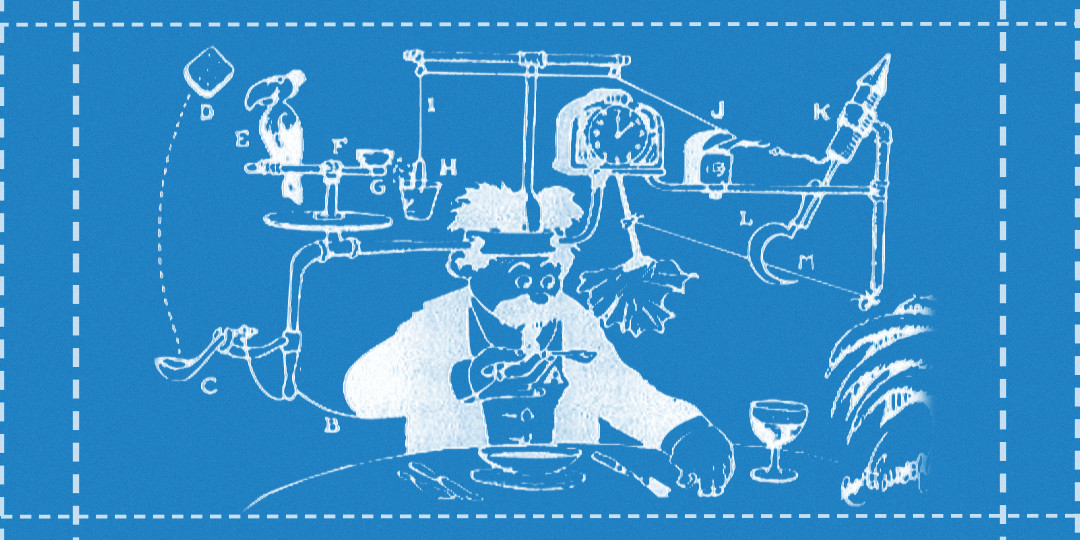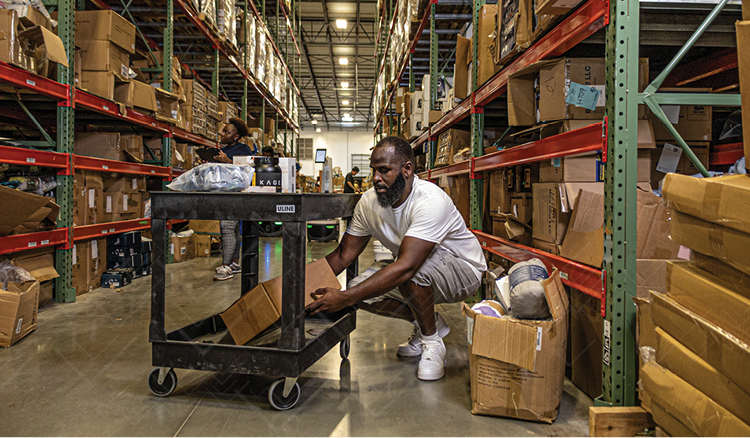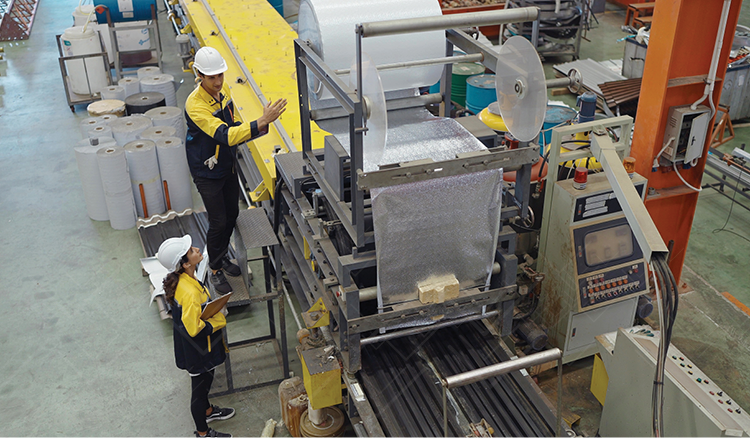The Rube Goldberg Problem in U.S. Manufacturing
US manufacturing has a problem. It’s not attracting enough workers, and its output lags behind where it needs to be if we are going to bring productive power back onto our shores en masse. What would otherwise be a simple equation has become muddled with variables and complexities that leave us worse off, as the global supply chain has shown us in the past year. US manufacturing is stuck in a giant Rube Goldberg machine, propped up by tinier complexities at the individual facility level.
To understand the metaphor, you need to know about the Rube Goldberg machine’s namesake. Goldberg was a well-known American cartoonist whose humorous drawings portrayed ridiculously complex machines built to accomplish simple tasks. These machines came to be known as Rube Goldberg machines.
You will see in the example below how silly these are. A diner’s spoon triggers a lever that flings toast to a bird, which tilts a seesaw, which pulls a string to launch a firework, which cuts a cable to release a napkin, which wipes the diner’s mouth after he eats a bite of his soup. That’s a lot of work just to wipe your mouth with a napkin!

The micro-scale Rube Goldberg problem in manufacturing
Much like the overly complicated contraptions in these drawings, manufacturing is facing some problems it has made for itself. If you examine the work processes in your facility, chances are that you’ll find something that looks like a Rube Goldberg machine. Maybe one workstation is doing too many steps for one station, or the work is overly complex for what really needs to be accomplished.
Perhaps the worst case of this is when someone holds knowledge about their work hostage, claiming that they are the only one who can do it. They’re running a hidden Rube Goldberg machine inside your operation by excluding anyone else from learning to do their work. In the best case, the work isn’t as complicated as they think, and in the worst case, it actually is that complicated.
When you have complicated tasks in your operation that only someone with years of training can perform, you also run the risk of that person quitting, moving, or retiring, thus leaving you out of luck. This tribal knowledge and the needlessly exclusionary work processes that encourage it make life harder for you.
We’re happy to say that there is a better way; one that unlocks new potential for your company and involves more workers in the workforce. But it will require some work on your part if you wish to increase your capabilities and create flexibility in your operation.
Solving the micro-scale problem: simplify tasks to increase productivity
To easily respond to demand, you will need to make work easier. It isn’t always easy to accomplish this, but your ideal state is that anyone should be able to walk in and learn most of the tasks in your operation within an hour.
This is how Henry Ford unlocked huge gains with the production line; by breaking down tasks into the smallest, most easily repeated parts so that each person has less steps to do, he increased productivity tremendously.
When was the last time you thought critically about which parts of your operation could be made easier? When was the last time you took a walk on the shop floor and simplified something?

The macro-scale Rube Goldberg problem in manufacturing
Zooming out from just your operation, there’s a bigger Rube Goldberg machine running in the manufacturing industry that’s perpetuated by an ongoing narrative around work. People and pundits tend to draw a line around what types of work are called “skilled” and what types of work are called “unskilled.” This line typically bends depending on whose agenda is being served at the time.
If you look at manufacturing work, most of it requires great skill, even if you can train someone to do it in a day. But because of this quick training time, many people would call this “unskilled” work.
Then there are specializations and specific machinery that take more time to learn. These tasks are labeled “skilled,” and are often kept difficult intentionally or accepted as a fact of life. “This task will just always be hard,” people say. The workers who have learned it are happy because it provides job security, and the business likes that they have something for workers to work towards. These roles are the proverbial carrot to incentivize performance through the promise of a more desirable position.
At Veryable, we would argue that “skilled” vs “unskilled” is an unproductive way of classifying the work being done in a manufacturing environment. It arbitrarily restricts the number of workers who can do any given task in the manufacturing industry and decouples labor costs from actual labor input.
Workers who have been working long enough to have specialized in something feel they have earned their “skilled” position and will no longer want to do work that they now see as “unskilled.”
On the other hand, workers who would otherwise enter the space are scared away by the label of “unskilled” being applied to work that is quite valuable and in fact requires great skill. They do not want to be seen as “unskilled,” so they avoid these types of work.
Beyond creating divisions on the shop floor, the “skilled” vs “unskilled” label decouples labor costs from actual labor input. If a complicated process or machine is requiring a skilled worker, but isn’t providing more value to the customer than a simpler step, then this “skilled” position is not justified based on the value it is creating. How “skilled” the position is considered does not necessarily correlate with value to the customer, therefore this is not a particularly useful label.
If you instead looked at the work through the lens of what ultimately provides value to the customer, you would see this whole thing differently. It would simplify this Rube Goldberg machine of overly complex roles and remove the stigma on manufacturing roles being viewed as “unskilled,” thus attracting more workers to the space.
Solving the macro-scale problem: think in terms of customer value rather than skill labels
We are so quick to go with the prevailing narrative that we often overlook the customer in the process. If the customer values the work getting done more quickly, and simplifying the work would allow more people to contribute and enable you to flex capacity to meet demand, then you should be doing just that.
This would mean shifting the way you place value on work. This doesn’t mean you should ignore labor market dynamics, but rather that you should be focused on designing the work in such a way that you can quickly train workers to do any task you require.
This does not mean that you should race to the bottom with regards to pay rates; rather, it means that you should not keep or construct barriers to work where they do not need to be. This only holds back your productivity and impedes improvement.
So the ideal way to plan your work would be working backwards from the customer value on a per-unit basis. Factor in profit margin, cost of goods sold, overhead, etc. and then you’re left with what you can pay for labor.
Take this per-unit cost and offer piecework pay at that amount, then watch as you see greater output from your labor. It won’t matter how they’re trained or what machine they’re using, they will be paid based on how many units they produce. This will incentivize improvements in your processes and drive your top line.
This means you’ll be viewing labor as the primary driver of value in your operation, and everything else will be subordinate to making sure that the workers can produce efficiently to meet all the demand you can capture. And you can capture much more demand and finely control your labor input when you create flexible capacity using on-demand labor.
The grassroots solution: unlocking flexibility with lower barriers to work
If you make tasks less complicated, then more people will be able to do them. That allows you to flex your capacity much more quickly, even to the point of responding within the day to demand variation.
Flexing your capacity to meet demand is where on-demand labor comes in. Using on-demand labor to build up a labor pool of workers who are familiar with your operation will enable you to match inputs to outputs precisely for maximum efficiency. And it all starts with simplifying your work.
When you’re ready to ditch the Rube Goldberg machines and flex your capacity with on-demand labor, create a free business profile with Veryable. We’ll walk you step by step through building your labor pool for making operational improvements.
Previous Posts
How Policy Constraints, Not Just Production Bottlenecks, Threaten Your Bottom Line
The Future of Manufacturing and Logistics
Create a free business profile today to explore our platform.






